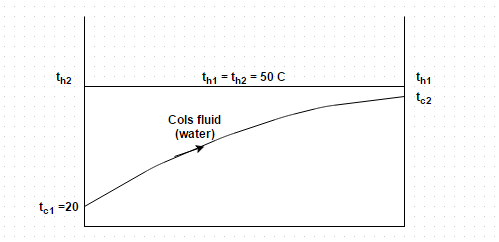Question

a.
647.46 W/m² degree
b.
747.46 W/m² degree
c.
847.46 W/m² degree
d.
947.46 W/m² degree
Posted under Heat Transfer
Interact with the Community - Share Your Thoughts
Uncertain About the Answer? Seek Clarification Here.
Understand the Explanation? Include it Here.
Q. A single pass shell and tube heat exchanger, consisting of a bundle of 100 tubes (inner diameter 25 mm and thickness 2 mm) is used for heating 28 kg/s of water from 25 degree...
Similar Questions
Explore Relevant Multiple Choice Questions (MCQs)
Q. A two pass surface condenser is required to handle the exhaust from a turbine developing 15 MW with specific steam consumption of 5 kg/k W h. The quality of exhaust steam is 0.9, the condenser vacuum is 66 cm of mercury while the bar meter reads 76 cm of mercury. The condenser tubes are 28 mm inside diameter, 4 mm thick and water flows through tubes with a speed of 3 m/s and inlet temperature 20 degree Celsius. All the steam is condensed, the condensate is saturated water and temperature of cooling water at exit is 5 degree Celsius less than the condensate temperature. Assuming that overall coefficient of heat transfer is 4 k W/m² degree, determine the mass of cooling water circulated.
View solution
Q. Consider the diagram given below and identify the correct option
View solution
Q. A plate 0.3 m long is placed at zero angle of incidence in a stream of 15 degree Celsius water moving at 1 m/s. Find out the maximum value of the normal component of velocity at thr trailing edge of the plate. For water at 15 degree Celsius
p = 998.9 kg /m³
µ = 415.85 * 10¯² kg/hr m
View solution
Q. Air at 25 degree Celsius flows over a flat surface with a sharp leading edge at 1.5 m/s. Find the value of Reynolds number. For air at 25 degree Celsius, kinematic viscosity = 15.53* 10n¯⁶ m²/s
View solution
Q. Boundary layer thickness is given by
View solution
Q. Shear stress at the middle of the plate is given by
View solution
Q. A plate 0.3 m long is placed at zero angle of incidence in a stream of 15 degree Celsius water moving at 1 m/s. Find out the maximum boundary layer thickness. For water at 15 degree Celsius. For water at 15 degree Celsius
p = 998.9 kg /m³
µ = 415.85 * 10¯² kg/hr m
View solution
Q. Local skin friction coefficient is given by
View solution
Q. Air at 25 degree Celsius flows over a flat surface with a sharp leading edge at 1.5 m/s. Find the boundary layer thickness at 0.5 from the leading edge. For air at 25 degree Celsius, kinematic viscosity = 15.53* 10n¯⁶ m²/s
View solution
Q. A plate 0.3 m long is placed at zero angle of incidence in a stream of 15 degree Celsius water moving at 1 m/s. Find out the stream wise velocity component at the mid-point of the boundary layer. For water at 15 degree Celsius
p = 998.9 kg /m³
µ = 415.85 * 10¯² kg/hr m
View solution
Q. Glycerin at 10 degree Celsius flows past a flat plate at 20 m/s. Workout the velocity components at a point P(x, y) in the fluid flow where
x = 2 m from the leading edge of the plate
y = 5 cm from the plate surface
For glycerin at 10 degree Celsius, kinematic viscosity = 2.79 * 10¯³ m²/s
View solution
Q. The boundary layer thickness is taken to be at a distance from the plate surface to a point at which the velocity is given by
View solution
Q. What is the value of thickness of the boundary layer at leading edge of the plate?
View solution
Q. The entrance length required for the flow to become fully-developed turbulent flow is dependent on
(i) Surface finish
(ii) Downstream conditions
(iii) Fluid properties
Identify the correct answer
View solution
Q. The transition from laminar to turbulent pattern of flow occurs at values of Reynolds number between
View solution
Q. The pattern of flow in the boundary layer is judged by the
View solution
Q. The conditions for flow beyond the boundary layer and its outer edge are
View solution
Q. The thin layer where velocity changes continuously is called
View solution
Q. The free stream undisturbed flow has a uniform velocity U INFINITY in the
View solution
Q. The concept of hydrodynamic boundary layer was first suggested by
View solution
Recommended Subjects
Are you eager to expand your knowledge beyond Heat Transfer? We've handpicked a range of related categories that you might find intriguing.
Click on the categories below to discover a wealth of MCQs and enrich your understanding of various subjects. Happy exploring!








